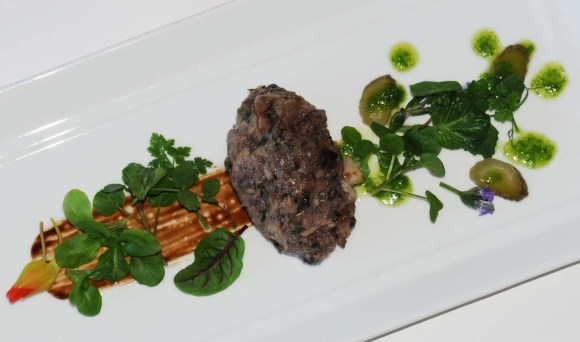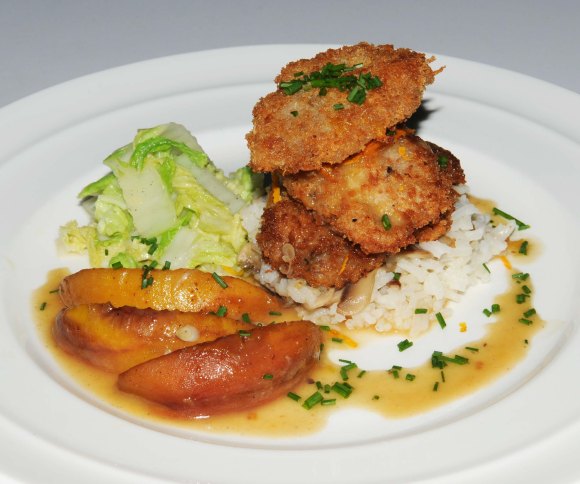This is one of the many dishes that can develop out of a roasted pig’s head

For the pig’s head:
½ pig’s head (if you can only buy a whole head, ask you butcher to cut it in half for you and freeze the other half for later use)
1 carrot, roughly chopped
1 medium onion, roughly chopped
1 stick celery, roughly chopped
2 garlic cloves, crushed
4 cloves
salt and pepper
1 liter/2 pts pork stock
½ cup duck fat, hot
For the duck giblets confit:
500g/1 lb duck giblets (excluding the liver)
salt and pepper
1 liter/2 pts duck fat
For the paté:
the cooked pork meat
the cooked duck giblets
a pinch of five-spice powder
1 tablespoon/15 ml rice wine vinegar
2 tablespoons/30 ml spring onions, finely chopped
Remove any hair on the skin, paying special attention to the eyes, ears and snout, by using a blow torch. Then scrub well in all the crevices using a vegetable brush. If need be you will have to shave off the stubborn hairs but hopefully the butchery will see to that. Rub the salt all over into the skin, fold a clean cloth (not plastic) loosely around it and let sit in the refrigerator for at least 24 hours.
Rinse well with cold water and pat dry. There will be lots of excess fat and it is better to remove as much as possible. (It can be rendered down for use some other time.) Place the head on a cake rack in the sink and pour a kettle full of boiling water over. Leave to cool.
Preheat the oven to 190°C/375°F.
Rub salt and pepper all over the skin and underneath. I suggest that you cover the ears with some foil to stop it from burning. I did not do it and the ears dried out quite a lot.
Prepare a baking tray big enough for the pig’s head to fit in and add the carrots, onions, celery, garlic and onion with the pork stock. Place the head on top of the vegetables, then pour the hot duck fat over the head. Bake in the preheated oven for 1½ hours then lower the heat to 160°C/325°F and bake for an additional 2 hours. When the head is cooked and browned nicely, remove it from the oven and cool until it is comfortable to handle. Strain the pan juices and reduce to a syrupy consistency, removing as much of the fat as possible.
Carefully remove the skin so that you have quite a few large pieces and set aside. Cut away as much as possible and separate the rest from the meat. Finely slice the meat and moisten it with the reduced pan juices. At this stage serve with a salad or on bread but if you want to continue with the recipe and add the Duck giblets to it, put it in a sealed container and refrigerate.
When the pork is out of the oven, lower the oven heat to 80°C/175°F.
Clean the duck giblets and cut away all the loose bits of fat and sinew. Cut off the tough stomach wall and slice everything into small cubes. In a small ovenproof saucepan, heat the duck fat to 80°C/175°F, season the giblets with salt and pepper and add to the fat. Place the saucepan in the heated oven and cook for 3 hours. Remove from the oven and let the giblets cool in the fat.
When ready to assemble the paté, remove the giblets from the fat and drain, trying to get rid of as much of the fat as possible.
Assemble the paté:
Mix all the ingredients together, check the seasoning and add more salt if necessary. Put everything in a food processor and pulse until you have a rough consistency.
If you want a smooth paté, grind it longer until you are satisfied.
Pack the mixture tightly into ramekins or any other container in which you can serve the paté directly. Keep in the refrigerator for at least 24 hours to give the flavors a chance develop.
Serve with thin slices of toasted bread, mango chutney and cornichons. Add some salad leaves if you wish.

